
The key to understanding the surface of Mars is stored in Oslo
A mineral collection in Oslo will help us understand the surface of Mars. But now the Mars rover that was to be sent to Mars in September will be postponed until 2028.
Scientists have collected minerals from the Earth's surface to understand the rocks found on Mars.
“We use these samples to build both a digital library and a collection of materials. The point is to have datasets from different instruments to be able to more easily understand what they will find there,” says Stephanie C. Werner, a professor at the University of Oslo.
Werner has led a European project called PTAL, the Planetary Terrestrial Analogues Library. Here, researchers from Oslo, Paris and Valladolid have tried to find ‘terrestrial analogues’, or minerals on Earth that correspond to what can be found on Mars and other planets and moons in the solar system.
“Each material has been completely described. The idea is to then compare it with real samples from Mars,” says Werner.

Postponed to 2028
But it’s going to take longer than planned. The Exomars program, which was supposed to be the first European rover to Mars, has broken off cooperation with the Russian space agency Roskosmos.
“The launch has been further delayed, probably until 2028, because we can’t use the Russian rocket in 2024,” Werner said.
This is daily life for scientists who study other planets. Often, scientists who begin a research project will have long been retired by the time a space probe finally reaches the planet they began studying.
“At the same time, we already have the Mars 2020 rover Perseverance in place. It also has instruments that we have used in our projects. It will be able to benefit from what we know about the rock samples we have collected on Earth,” Werner said.
Different atmosphere
The PTAL project has collected volcanic rocks and then exposed them to experiments with chemical changes that simulate Martian weather, Werner said.
The biggest difference between Earth and Mars when it comes to rock weathering is the composition of the atmosphere. The Mars atmosphere contains 95 per cent CO2 and less than 3 per cent nitrogen. By comparison, the Earth's atmosphere consists of 78 per cent nitrogen, 21 per cent oxygen and only 0.04 per cent CO2. The environment on Mars is also much more acidic than on Earth.
“Clay minerals are also different because the Martian atmosphere doesn’t contain any oxygen. The climate there has produced the same minerals, but in completely different ways,” Werner said.
Minerals and data
The physical minerals collection is now housed at the University of Oslo. In addition, the project has created a database. Both are freely available to researchers who need them for new experiments and projects.
The data isn’t only for comparison of samples that Perseverance and later visitors take on and below the Martian surface. They can also benefit researchers who use satellite data to learn more about Mars and the rest of the solar system.
Perseverance has spent 400 days on the surface of Mars now. On April 13, the rover arrived at an ancient river delta in the Jezero Crater.
“The delta promises to be a veritable geological smorgasbord and one of the best places on Mars to look for signs of past microscopic life,” wrote NASA’s Thomas Zurbuchen in an update on the space administration's website.
“The answers are out there, and Team Perseverance is ready to find them,” he said. The fan-shaped delta contains large amounts of fine-grained deposits that are considered the best opportunity to find preserved remains of prehistoric life forms.
Perseverance will drill into the surface to collect samples to be sent back to Earth.
Translated by Nancy Bazilchuk
References:
Henning Dypvik et.al: The Planetary Terrestrial Analogues Library (PTAL) - An exclusive lithological selection of possible Martian Earth analogues. Planetary and Space Science, 2021.
Fernando Rull et.al: Spectroscopic study of terrestrial analogues to support rover missions to Mars - A Raman-centered review. Analytica Chimica Acta, 2021.
Marco Veneranda et al: Raman spectroscopy and planetary exploration: Testing the ExoMars / RLS system at the Tabernas Desert (Spain). Microchemical Journal, 2021. (Summary)
Cateline Lantz et.al: Planetary Terrestrial Analogues Library project: 1. characterization of samples by near-infrared point spectrometer. Planetary and Space Science, 2020.
Marco Veneranda et.al: Spectroscopic study of olivine-bearing rocks and its relevance to the ExoMars rover mission. Spectrochimica Acta Part A: Molecular and Biomolecular Spectroscopy, 2019. (Summary)
———
Read the Norwegian version of this article at forskning.no
































